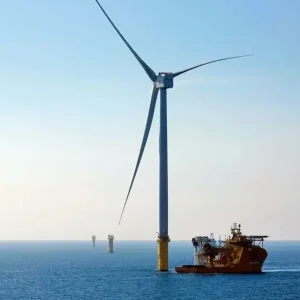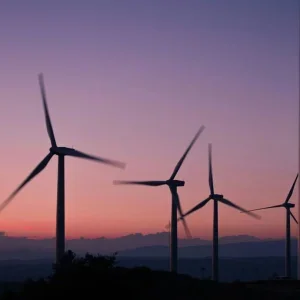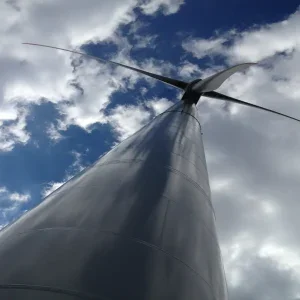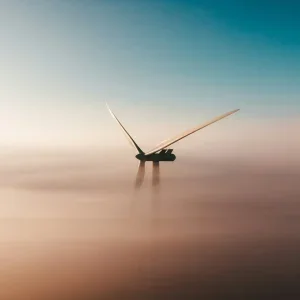Scotland has opened the world’s first full-scale floating wind farm, the 30MW Hywind, comprising five 11,500t, 6MW turbines made by the Norwegian oil company Statoil in collaboration with Abu Dhabi’s Future Energy Company, Masdar.
It will provide electricity for 20,000 homes from offshore wind turbines in much deeper water that is not suitable for conventional bottomstanding turbines. The wind farm officially opened on 18 October 2017, and demonstrates the huge strides taken in the field in terms of innovation and international collaboration by increasing turbine efficiency and blade sizes. Hywind has also placed the UK as number one, globally, for installed conventional wind farm capacity.
“This is a tech development project to ensure it is working in open sea conditions,” said Leif Delp, project director for Hywind. “It is a gamechanger for floating wind power, and we are sure it will help bring costs down. I think eventually that we will see floating wind farms compete without subsidy, but to do that we need to get building at scale.”
Groundbreaking design and technology
According to Statoil, floating windmill technology started with the Norwegian multinational’s daring design 16 years ago, when the company tested a pilot floating turbine on the north-west coast of Norway. Hywind represented the first configuration of a floating wind farm anywhere in the world.
The turbines in Hywind have been upscaled from 2.3MW in the original pilot in Norway to 6.0MW each, so all elements of the windmill had to become much bigger. Statoil said that the most important part of the design is the float motion controller, but the biggest challenge was in the installation process when the turbine had to be placed on the top of the floating base, which is attached via three cables in a triangular configuration to the suction anchors on the seabed.
Although groundbreaking innovation defines Hywind throughout, Statoil pointed out that the floating substructure itself made the biggest difference between conventional offshore and floating offshore turbines.
All onshore work was performed by the UK construction company Balfour Beatty Scotland, including the assembly of the underwater cables and the suction anchors, which weigh 110t each and were made by the Spanish company Nevantia.
Statoil says the blades software holds the tower upright by twisting the blades to dampen motions from wind, waves and currents. Without this customised software, the farms would not be able to operate in a deep-water environment, making it a crucial technology for Hywind as it offers the prospect of bringing down the overall price of wind power.
The turbine installation uses tug boats, heavy cables and remotecontrolled submarines while the units tether. The turbines can be anchored in waters up to 120m deep and sustain the pressure of winds with average speeds of between 10–20mph, to a maximum of 40mph. Statoil assembled the turbines in Norway and then transported them by sea.
Manage the onshore operations
The onshore operations and maintenance base for Hywind Scotland is located in Peterhead, Aberdeenshire, while the operations centre is based in Great Yarmouth in England. This allowed a concentration of research and management functions, which is crucial for a project where a number of Scottish subcontractors were involved.
Statoil said that, overall, the biggest operational challenge was the project management of the subcontractors as well as building and moving the giant anchors.
The 30MW Hywind wind park will connect to the 1MW/h Batwind storage facility, which will optimise Hywind’s electric production output by mitigating the intermittency of wind energy. Hywind Scotland will be connected to a 1MW/h lithium battery. Once installed, the Batwind storage will have the same battery capacity as two million smartphones.
Statoil is collaborating on the Batwind project with Scottish universities, the Scottish Government, the Offshore Renewable Energy Catapult and Scottish Enterprise. A senior Statoil representative claimed that the technology qualifying programme will guarantee a continuity of technology development in floating offshore farms in the UK and can be exported internationally.
“Our support for floating offshore wind is a testament to this government’s commitment to the development of this technology and, coupled with Statoil’s battery storage project, Batwind, puts us at the forefront of this global race and positions Scotland as a world centre for energy innovation,” said Scottish First Minister Nicola Sturgeon at the inauguration of the project earlier in the autumn.
Sian Wilson of Crown Estate Scotland, the company leasing the Scottish seabed to renewables developers, said the organisation is committed to encouraging floating offshore wind projects, which will, in turn, drive down costs, benefitting the whole sector, the climate and consumers.
Competitive pricing for offshore floating wind farms
State-owned Statoil is funding 75% of the £210-million Hywind project, with the remaining 25% provided by Masdar.
Similar to other renewable energy projects, the new wind farm qualifies for financial support (for each unit it produces) only when it starts generating electricity – in this case, that support comes from the Renewables Obligation scheme funded by UK consumers through electricity bills.
Following its completion at the end of 2017, the Hywind farm is expected to encourage new orders for similar farms in the US and Japan, and is considered a trial showcase project that will allow Statoil to expand its floating turbine expertise. According to Statoil, the output from the giant floating turbines is expected to equal or surpass generation from existing conventional wind turbines.
“Hywind [turbines] can be used for water depths up to 800m, thus opening up areas that so far have been inaccessible for offshore wind,” said Irene Rummelhoff, executive vice-president of the new energy solutions business area in Statoil. “The learnings from Hywind Scotland will pave the way for new global market opportunities for floating offshore wind energy”. The cost of floating wind power technology is largely expected to follow a similar downward trajectory to that of onshore and bottom-fixed offshore wind power. For example, in a recent contract for difference (CFD) auction for the construction of future offshore wind capacity, Dong Energy and Spain’s EDP were awarded a strike price of £57.50 per MW/h for construction of the Hornsea 2 and Moray Offshore wind farms. The strike price is a future power price agreed between a generation asset owner and the UK Government to help fund new power generation construction. This contrasts with £92.50 per MW/h for the construction of Hinkley Point C’s planned 3,200MW nuclear power station in western England.
If the price of power over a set contractual period (the CFD) falls below the agreed strike price, the UK Government will pay the difference to the generation asset owner. If the price of power rises above the strike price during the period of the CFD, then the generation asset owner will pay the UK Government back the difference.
According to Statoil, the overall offshore wind sector has the potential to grow from a global capacity of 13GW in 2015 to more than 100GW by 2030, with floating wind technology accounting for a significant share of that expansion. Moreover, Statoil has the ambition to reduce energy costs from the Hywind floating wind farm to €40−60 per MW/h by 2030, according to Rummelhoff.
“Knowing that up to 80% of the offshore wind resources are in deep waters (more than 60m) where traditional bottom-fixed installations are not suitable, floating offshore wind is expected to play a significant role in the growth of offshore wind going forward,” she said.
Good prospects for floating offshore farms
Currently, conventional offshore wind turbines power four million homes in the UK, and will power more than eight million by 2020, making offshore wind the lowest-cost option for large-scale, low-carbon power. The price of offshore wind is 32% lower than in 2012, and is getting cheaper more rapidly than initially predicted and four years ahead of the governmental predictions.
Moreover, the price of offshore wind power has dropped by 50% in the past five years and is cheaper than nuclear power, according to a National Audit Office (NAO) report.
“The phenomenal growth of the UK’s world-leading offshore wind industry is an industrial success story made possible by tens of thousands of tenacious innovators and gamechangers all around this country working in renewable energy,” said Hugh McNeal, Renewable UK’s chief executive. “Offshore wind is a key technology in reducing carbon emissions by more than 7.5 million tons a year.”
Wind turbines have more than doubled their power capacity since 2007. The current generation of 8MW turbines have 260ft blades, spanning an area the size of the London Eye. With a single rotation, these blades generate enough energy to power a home for 24 hours. By the mid-2020s, turbine capacities are set to double again, reaching 15MW. These advances in turbine technology have played a big part in driving recent reductions in costs-per-megawatt-hour.
Moreover, offshore wind farms can be built in just two or three years, minimising the risk of cost overruns and ensuring that technological advances are adopted quickly.
“These ongoing cost reductions show that offshore wind is in pole position to be the foremost low-carbon power source, with the UK as the global market leader,” said Jonathan Cole, managing director for Offshore Wind at Scottish Power Renewables.
The offshore wind industry is one of the UK’s largest infrastructure programmes, according to HM Treasury, while job creation in the sector is focused in regions in need of regeneration, such as the north-east of England. This is the reason Siemens’ £310-million turbine blade factory is based in Hull, creating 1,000 new fulltime jobs. According to Catapult, an innovation test-bed organisation, the UK will receive £27.5 billion in investment in UK offshore wind projects by 2021.
“Southern Electric (SSE) is currently investing in much needed energy infrastructure that contributes to UK growth with offshore wind becoming an affordable form of large-scale, lowcarbon energy, we believe that the UK as a whole will benefit from these cost reductions,” said Paul Cooley, SSE’s director of generation development.
Vattenfall is also investing in UK offshore wind for the long term. Its Norfolk Vanguard, Norfolk Boreas and Thanet Extension projects will be even more competitive than today’s successful projects, according to Piers Guy, UK Country Manager.
Hywind is the second offshore wind partnership between Masdar and Statoil following the Dudgeon wind farm, a 402MW project also due to come on-stream in the end of the second half of 2017.






